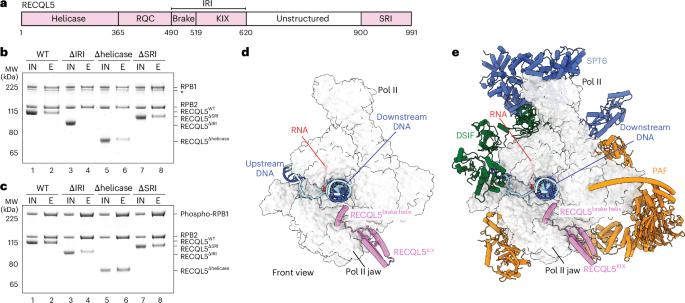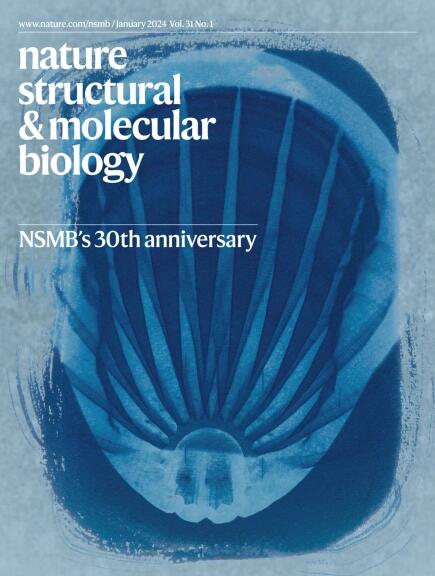Structural basis of RECQL5-induced RNA polymerase II transcription braking and subsequent reactivation
IF 10.1
1区 生物学
Q1 BIOCHEMISTRY & MOLECULAR BIOLOGY
引用次数: 0
Abstract
Abnormally fast transcription elongation can lead to detrimental consequences such as transcription–replication collisions, altered alternative splicing patterns and genome instability. Therefore, elongating RNA polymerase II (Pol II) requires mechanisms to slow its progression, yet the molecular basis of transcription braking remains unclear. RECQL5 is a DNA helicase that functions as a general elongation factor by slowing down Pol II. Here we report cryo-electron microscopy structures of human RECQL5 bound to multiple transcription elongation complexes. Combined with biochemical analysis, we identify an α-helix of RECQL5 responsible for binding Pol II and slowdown of transcription elongation. We further reveal that the transcription-coupled DNA repair (TCR) complex allows Pol II to overcome RECQL5-induced transcription braking through concerted actions of its translocase activity and competition with RECQL5 for engaging Pol II. Additionally, RECQL5 inhibits TCR-mediated Pol II ubiquitination to prevent activation of the DNA repair pathway. Our results suggest a model in which RECQL5 and the TCR complex coordinately regulate transcription elongation rates to ensure transcription efficiency while maintaining genome stability. Using cryo-electron microscopy and biochemistry, Zhang et al. reveal that the DNA helicase RECQL5 and the transcription-coupled DNA repair complex coordinate to regulate transcription elongation rates and maintain genome stability.


recql5诱导RNA聚合酶II转录抑制及随后再激活的结构基础
异常快速的转录延伸可能导致有害的后果,如转录-复制碰撞,改变的可选剪接模式和基因组不稳定。因此,延长RNA聚合酶II (Pol II)需要减缓其进展的机制,但转录制动的分子基础尚不清楚。RECQL5是一种DNA解旋酶,通过减缓Pol II而发挥一般延伸因子的作用。在这里,我们报告了人类RECQL5结合多个转录延伸复合物的低温电镜结构。结合生化分析,我们确定了RECQL5的α-螺旋负责结合Pol II和减缓转录延伸。我们进一步发现,转录偶联DNA修复(TCR)复合体允许Pol II通过其转位酶活性的协同作用和与RECQL5的竞争来克服RECQL5诱导的转录制动。此外,RECQL5抑制tcr介导的Pol II泛素化,从而阻止DNA修复途径的激活。我们的研究结果表明,RECQL5和TCR复合体协调调节转录延伸率,以确保转录效率,同时保持基因组的稳定性。
本文章由计算机程序翻译,如有差异,请以英文原文为准。
求助全文
约1分钟内获得全文
求助全文
来源期刊

Nature Structural & Molecular Biology
BIOCHEMISTRY & MOLECULAR BIOLOGY-BIOPHYSICS
CiteScore
22.00
自引率
1.80%
发文量
160
审稿时长
3-8 weeks
期刊介绍:
Nature Structural & Molecular Biology is a comprehensive platform that combines structural and molecular research. Our journal focuses on exploring the functional and mechanistic aspects of biological processes, emphasizing how molecular components collaborate to achieve a particular function. While structural data can shed light on these insights, our publication does not require them as a prerequisite.
 求助内容:
求助内容: 应助结果提醒方式:
应助结果提醒方式:


